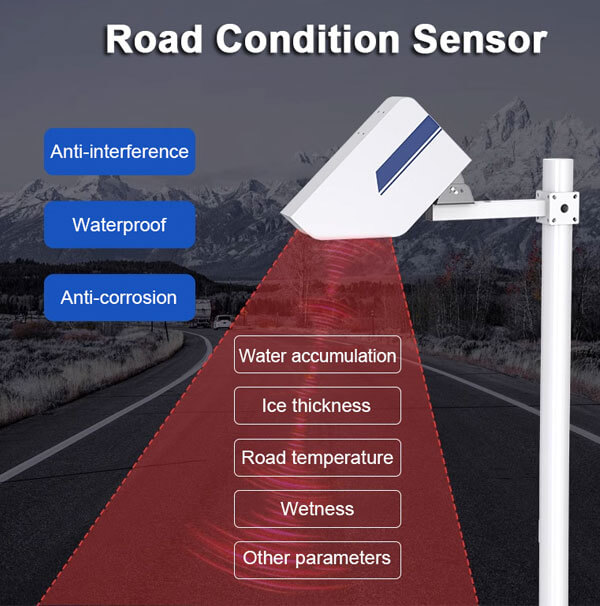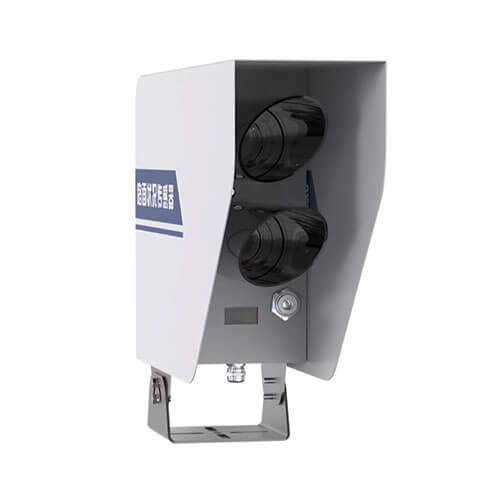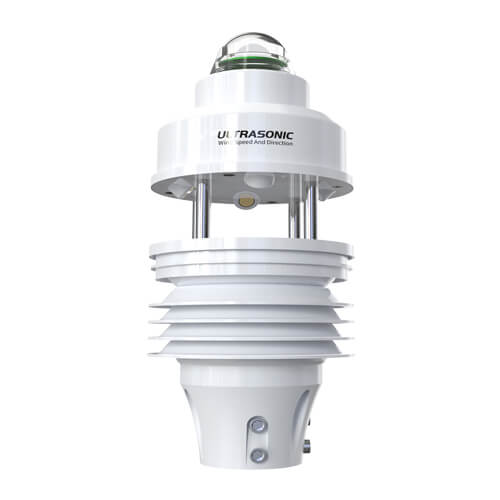Table of Contents What is Hydrology? Hydrology refers to the various phenomena of water changes and movement in nature. It studies the formation, circulation, spatial
Road Condition Sensor
The road condition sensor developed and produced by our company is a multifunctional device that can monitor road temperature, water accumulation, ice thickness and snow thickness. It adopts non-contact measurement method and will not damage the road. The lens has a built-in heating function, which can effectively prevent the lens from icing or frosting. The shell of the road condition sensor has been treated with anti-corrosion and is resistant to rain corrosion. The laser light source and the added filter design can effectively resist light source interference.
- Model: RS-LMK-N01-1-EX
- MOQ: 1 PCS
- Delivery date: within 24 hours
- Price:$1548.4
Renke Road Condition Sensor
The road condition sensor, also known as the road surface sensor or remote sensing road sensor, is a key device that uses advanced remote sensing technology to monitor road conditions in real time. It uses a non-contact detection mode to accurately measure road conditions such as ice, snow, water and their thickness by emitting light and receiving spectral information reflected by the road surface.

Road sensor features
The working principle of the road condition sensor is spectral analysis technology. Its built-in transmitting light source can emit monochromatic light of a single wavelength, which is focused by a lens and irradiated onto the road surface. Due to the different road materials and conditions, the intensity and spectral characteristics of the reflected light are also different. The spectral receiving unit in the road condition sensor can accurately measure the intensity and wavelength of the reflected light. After analysis by the processing unit, it finally outputs the analysis results of the road condition, such as dry, slippery, icy and other conditions. The DC power supply circuit of this device has a dual design of anti-reverse connection and self-recovery insurance. Road condition sensors are widely used in various traffic scenarios, including highways, urban roads, airport runways, bridges and tunnels, etc.
Road sensor datasheets
| Power supply | 11~28V DC |
|---|---|
| Power consumption | 1.5W (heating power 13w) |
| Output method | RS485 |
| Measure distance and diameter | 2-10m, 25cm |
| Angle range | 0~60° |
| Road surface conditions | dry, damp, wet, waterlogged, iced, snowy |
| Water thickness | 0.00~2.00mm |
| Ice thickness | 0.00~2.00mm |
| Snow thickness (optional) | 50mm~2500mm |
| Road surface temperature | -30℃~60℃ |
| Wetness | 0.00~1.00 (dangerous~dry) |
| Update interval | 20s |
| Working environment | -40~60℃, not more than 95% (30℃) |
Road Condition Sensor Installation
Step 1
1. Take the road condition sensor out of the packaging box, and check the equipment accessories carefully against the packing list of the instruction manual.
2. Carefully read the instruction manual and certificate of the road condition sensor.
3. Choose a suitable location to install the road condition sensor. The package provides a cross arm and mounting clamp. First install the sensor on the cross arm.
Step 2
Then use the clamp to fix the cross arm and the device together on a 75mm vertical pole.
The pole is not included in our product list. You can prepare it yourself or buy it from our company at an additional cost.

Step 3
Adjust the road condition sensor according to the measurement distance requirements of the installation location. On the one hand, the installation height can be adjusted, and on the other hand, the angle between the sensor and the mounting bracket can be adjusted. These two methods can meet the requirements of the measurement position. When adjusting the angle, you can configure the software to view the installation angle value of the device. The recommended range is between 10~40°.
(Note: According to the installation angle and height, calculate the measurement distance c and measurement range d. If the measurement position is not ideal, adjust the installation angle and height of the road condition sensor.)
Renke Road Condition Sensor
1. What is included in the road condition sensor package?
- Road condition sensor*1
- Cross arm*1
- Clamp*1
- Mounting screws (M5*55 hexagon screws*3, M5 nuts*3, M8*50 hexagon screws*3, M8 nuts*3)
2. How to wire the road condition sensor?
Our sensor uses a wide voltage, and the power input can be 11~30V. When wiring the RS485 signal line, please note that the A and B lines cannot be connected in reverse, and the addresses of multiple devices on the bus cannot conflict. Specific wiring: the brown line is the positive power supply, the black line is the negative power supply, the yellow line is 485-A, and the blue line is 485-B.
3. Register address of road condition sensor
| Register address (hexadecimal) | PLC or configuration address (decimal) | Content | Operation |
|---|---|---|---|
| 0000 H | 40001 | Road conditions: 0 (error), 1 (dry), 2 (wet), 3 (wet), 4 (flooded), 7 (icy) | 03 |
| 0001 H | 40001 | Road condition: 0 (bad), 1 (dry), 2 (wet), 3 (wet), 4 (waterlogged), 7 (icy) | 03 |
| 0002 H | 40003 | Floating point high position of water accumulation thickness | 03 |
| 0003 H | 40003 | Floating point low position of water thickness | 03 |
| 0004 H | 40005 | Floating point high position of ice thickness | 03 |
| 0005 H | 40006 | Floating point low position of ice thickness | 03 |
| 0006 H | 40007 | Floating point high position of snow depth | 03 |
| 0007 H | 40008 | Floating point low position of snow depth | 03 |
| 0008 H | 40009 | Floating point high position of road surface temperature | 03 |
| 0009 H | 40010 | Floating point low position of road surface temperature | 03 |
| 000A H | 40011 | Floating point high position of equipment installation angle | 03 |
| 000B H | 40012 | Floating point low position of equipment installation angle | 03 |
| 000C H | 40013 | Wetness level floating point high | 03 |
| 000D H | 40014 | Wetness level floating point low | 03 |
| 0013 H | 40020 | Positioning enable: 0 (turn off the laser beam), 1 (turn on the laser beam) | 03/06/10 |
| 0015 H | 40022 | Calibration enable: write 1 for automatic calibration | 03/06/10 |
| 0056 H | 40087 | Water thickness calibration value: 16-bit unsigned, expanded 100 times | 03/06/10 |
| 0057 H | 40088 | Ice thickness calibration value: 16-bit unsigned, expanded 100 times | 03/06/10 |
| 0058 H | 40089 | Ice thickness calibration value: 16-bit unsigned, expanded 100 times | 03/06/10 |
| 0061 H | 40098 | Laser snow depth calibration: write 1 to automatically calibrate zero point | 03/06/10 |
| 07D0 H | 42001 | Device address: 1~254 | 03/06/10 |
| 07D1 H | 42002 | Baud rate: 0 is 2400, 1 is 4800, 2 is 9600, 3 is 19200, 4 is 38400, 5 is 57600, 6 is 115200, 7 is 1200 | 03/06/10 |
4. Why can't the road sensor be connected to the PLC or computer?
Possible reasons:
1. The computer has multiple COM ports, and the selected port is incorrect.
2. The device address is wrong, or there are devices with duplicate addresses (all factory defaults are 1).
3. Baud rate, check mode, data bit, stop bit error.
4. The host polling interval and waiting response time are too short, and both need to be set to more than 200ms.
5. The 485 bus is disconnected, or the A and B lines are connected in reverse.
6. There are too many devices or the wiring is too long. Power supply should be provided nearby, a 485 enhancer should be added, and a 120Ω terminal resistor should be added.
7. The USB to 485 driver is not installed or damaged.
8. The device is damaged.
5. What are the functions of road surface sensors?
Road condition sensors can monitor a variety of road information in real time and provide key data for transportation, aviation, tunnels and other fields. Taking the airport as an example, it can help airport managers understand the condition of the runway in a timely manner and ensure the safety of aircraft takeoff and landing. Specific functions include:
1. Detect whether there is water accumulation, ice, and snow on the road. These will greatly affect the safety of aircraft takeoff and landing. For example, an icy runway will increase the braking distance of the aircraft and may even cause the aircraft to skid.
2. Measure road temperature. The road temperature is very important for determining whether there is icing. In cold weather conditions, when the road temperature is close to the freezing point, preventive measures such as spraying deicing agents are needed.
3.Measure road humidity. Excessive humidity may cause the road to be slippery and affect the safety of aircraft takeoff and landing.
6. What are the types of road condition sensors?
Road condition sensors are mainly divided into two types: remote sensing and embedded. The remote sensing type is based on optical principles. It detects the thickness of water, ice and snow on the road surface according to the different infrared spectral characteristics of water, ice and snow. The embedded type integrates multiple measuring probes and directly contacts the road surface. It can measure road surface temperature, water film height, ice thickness, friction coefficient, and accurately judge road conditions.
7. What are the dimensions of our road condition sensor?
Below is our road condition sensor size.

8. How to get the road sensor manual?
Leave us a message and we will send the manual to your email.
9. Why choose our road condition sensor?
Related Blogs
Table of Contents What is visibility? Visibility refers to the maximum distance at which a person with normal vision can identify a target from the
Table of Contents The Internet of Things (IoT) is one of the hottest technology words in the past few years, which can collect, share, analyze
Table of Contents As an advanced and well-known technology, ultrasonic sensor is widely used in various consumer and industrial fields. When adding distance measurement or
Table of Contents We know that the risk of vehicle accidents on the road increases exponentially during heavy rain, fog and snowfall. According to the
Table of Contents Did you know? Atmospheric pressure is constantly influencing the natural phenomena around us—everything from the direction of winds, to cloud formation, and
Table of Contents The Automated Weather Station (AWS) is an important tool for meteorologists, environmentalists and other weather enthusiasts. It provides comprehensive data on weather
Table of Contents What is differential pressure? Differential pressure is the difference between the values of the pressures at different locations. For example, if the
Table of Contents The dew point depends on how much water vapor is present in the air. If the air is very dry with few









